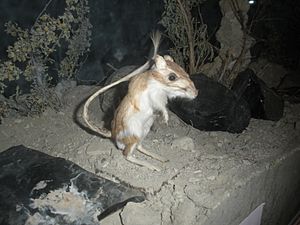Panamint kangaroo rat facts for kids
Quick facts for kids Panamint kangaroo rat |
|
|---|---|
 |
|
| A taxidermied Panamint kangaroo rat at a visitor center | |
| Conservation status | |
| Scientific classification | |
| Genus: |
Dipodomys
|
| Species: |
panamintinus
|
The Panamint kangaroo rat (Dipodomys panamintinus) is a type of rodent that belongs to the family Heteromyidae. It lives only in the Mojave Desert in eastern California and western Nevada, in the United States. This means it is endemic to that area.
Contents
What Does It Look Like?
The Panamint kangaroo rat is a medium-sized rodent compared to others in its group. Its fur is a light clay color. It has some blackish patches around its face.
Its tail is very long, about 1.4 times longer than its body. The tail has a white stripe and a thick tuft of hair at the end. This animal is named after the Panamint Valley and Panamint Range Mountains. These mountains are located just west of Death Valley.
The common name "kangaroo rat" comes from how it moves. It hops on two legs, much like a kangaroo. This way of moving is called bipedal hopping.
One special thing about the Panamint kangaroo rat is its hind feet. They have five toes, while other kangaroo rats usually have only four. Also, males are generally larger than females. This difference in size between sexes is called sexual dimorphism.
These kangaroo rats have special fur-lined pouches in their cheeks. They use these pouches to carry large amounts of food. The pouches keep the food separate from their mouth. This helps them save water, which is important in the desert.
Where Do They Live and What Do They Eat?
Home and Habitat
The Panamint kangaroo rat lives in a smaller area compared to some other kangaroo rat species. They are mostly found in the Great Basin bush desert. This area includes western Nevada and the eastern side of the Sierra Nevada mountains in California. Their home range also stretches south into the western Mojave Desert.
They usually live at higher elevations. You can find them between 1,200 and 1,950 meters (about 3,900 to 6,400 feet) above sea level.
Panamint kangaroo rats make their homes in holes. These holes are found in small sand mounds. These mounds often build up around clumps of desert plants. In the Panamint Mountains, one rat might live in a burrow with 12 or more tunnels. These tunnels are connected on the surface by clear paths. The size of their home area changes throughout the year. It is largest in February and July.
Diet
The Panamint kangaroo rat is a granivore. This means it mainly eats seeds. It gets most of its water from the food it eats. This is called metabolic water. Their diet changes with the seasons. However, they mostly eat seeds that are rich in carbohydrates.
They gather many seeds and pack them into their fur-lined cheek pouches. Some foods they eat include pinion pine seeds, juniper berries, green grass shoots, insects, and mesquite.
These rats store food in two ways. They do "scatter hoarding" by burying single seeds or small groups of seeds in the ground. They also do "larder hoarding" by storing seeds in their burrows and special chambers. How they store seeds affects how seeds are spread around their environment.
They rely a lot on their sense of smell, or olfactory senses. This helps them find their hidden seed stashes. They seem to find these hoards more easily when the weather is dry.
How Do They Behave?
The Panamint kangaroo rat is nocturnal. This means it is active at night. It does not hibernate, so it stays active all year. However, deep snow can limit its activity. These rats are usually solitary, meaning they live alone. They only come together during mating season.
How They Move
The Panamint kangaroo rat uses a very special way of moving on two legs. This is called bipedal locomotion. They change how they move based on their surroundings. For example, if they are not disturbed, they might hop on all four legs. They can also hop or walk on two legs.
If they get scared, their hopping changes. They make fast, unpredictable leaps on two legs to escape predators. Panamint kangaroo rats are also excellent swimmers. Their large hind feet help them move well in water. Their hop is usually about the same length as their body. The amount of water and food available can also affect how active the animal is.
Mating and Reproduction
How male and female kangaroo rats interact changes as the female goes through her estrus cycle, which is her mating period. If a male stays too close to a female, it might stop her cycle. So, for successful breeding, males and females usually live apart. They only come together briefly to mate.
Males will have larger home ranges during spring. This helps them find females for mating. The main breeding season is between February and March. A female usually has a litter of 3 to 4 young.
How Their Body Works
The Panamint kangaroo rat lives in a dry desert. Because of this, it has a special way to get water from its food. This is called metabolizing water. These kangaroo rats can produce very concentrated urine. This helps them save water in their bodies. When they don't have water, they only produce a tiny drop of urine every 1 to 2 hours.
Even though they live in a place with big temperature changes, these kangaroo rats have limited ways to control their body temperature. When the temperature goes above 35 °C (95 °F), they use their burrows. The burrows help them keep a stable body temperature.
See also
 In Spanish: Dipodomys panamintinus para niños
In Spanish: Dipodomys panamintinus para niños


